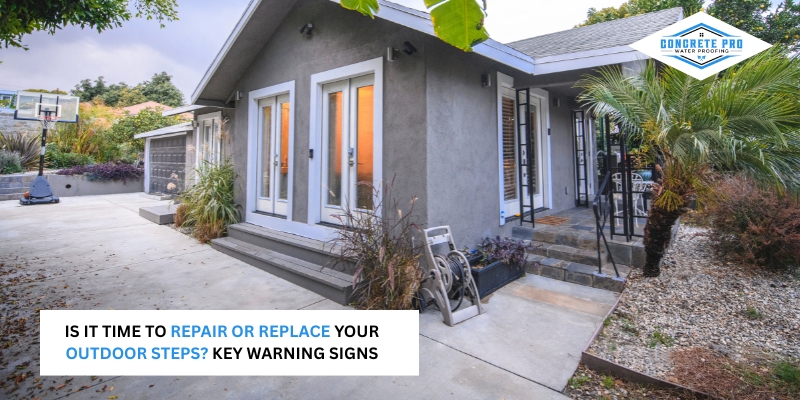
Your outdoor steps are not just a thoroughfare to your front door; they are a component of your home that contributes to safety and first impressions. With the effects of weather, use, and age, your steps can deteriorate to the point where they are no longer stable, attractive, or safe.
How do you know when to fix a few things versus the need to start over? We will discuss the signs and concerns that tell you if a repair will work—or if it's better (and safer) to replace your outdoor steps! Let's find out what to look for.
Why Outdoor Steps Matter
Functional elements of your home, like outdoor steps, contribute to curb appeal. They provide safe entry to your home and can contribute to the aesthetic element of your exterior. More critically, outdoor stairs can pose a safety risk if damaged or unstable. It is common for someone to trip, slip, or fall because of neglected stair maintenance; the injuries may turn into lawsuits…or worse. Recognizing the signs of trouble is an important skill to learn.
Common Materials and Expected Lifespan
Knowing what your steps are made of will help you better estimate the necessary maintenance and lifespan.
1. Concrete Steps
Concrete steps have an impressive lifespan of 20-30 years and are relatively low maintenance. However, they are susceptible to cracks and chips, particularly in areas where freezing and thawing happen.
2. Wooden Steps
The average 10- to 15-year lifespan of wooden steps varies with the quality of the wood and how long it is exposed to the weather. They are prone to rot, pests, and warping.
3. Brick Steps
These materials provide a lifespan exceeding 50 years but may require releveling or repointing in rare cases (because they can be affected by soil erosion or foundation movements).
4. Metal Steps
Metal, iron, or steel steps are stronger than their wooden counterparts, although they can rust if not correctly maintained.
The Most Dominant Warning Signs That Suggest Repair Is Required
The signs below do not necessarily indicate a complete replacement of your steps. Depending on the extent of the problem, a few touch-ups may be all that is necessary. These are the red flags to look out for:
1. Minor Cracks
Most cracks in brick or concrete are minor and may be filled or patched before they get larger. By catching these early, water seepage and further damage can be prevented.
2. Loose Railings
When your handrails are loosely swinging, tightening or reinforcement is required. This common repair can make the steps a lot safer.
3. Surface Wear
The edges may be chipped, paint may be peeling off, or erosion might occur. These cosmetic imperfections can be sanded, painted, or patched; the entire staircase must not be replaced.
4. Squeaky or Wobbly Wood Boards
Conditions involving wooden steps that are too squeaky or slippery may not involve serious repairs. Perhaps only a couple of nails or screws are needed to steady them, and the problem is solved.
Red Flags That Suggest It's Time for a Full Replacement
Although minor problems may be fixed by patching, sure signs mean severe structural issues. If you find any of the following, then replacing your steps may be preferable. This can sometimes be the safest and most cost-effective solution.
Deep Crack or Crumbling Concrete
Patching does not work well for concrete steps that are broken in many areas. This is usually an indication of structural degradation.
Rotten Wood
When two or more steps are weak, soft, and/or cracked or visibly rotten, the whole staircase may be unsafe. Rot destroys strength. When it has established itself in a few points, the only thing to do is to replace them.
Sinking or Movement
Steps that look unequal, sinking, or moving away from the house may show foundation problems or soil displacement. This is not just an issue of cosmetics; it is a significant safety concern.
Rusting Metal
In the case of metal staircases, rust effects, such as rusting around the joints and connections, will compromise structural strength. Where rust has eaten away areas of the steps or railing, the best option is replacement.
Several Repairs over the Years
If you have been repairing the same stairs over the years, replacing them with new ones may be wise. The accumulation of frequent obsolescence repair costs is a pain.
When to Seek the Help of a Professional
Problems are not always easy to identify; some can be more serious than they first appear. An expert should be involved if:
- You do not know to what extent your stairs are damaged.
- Steps are seen to be moving or sinking in the picture
- The presence of pooling water or drainage problems is observed.
- Updated building codes or regulations must be followed.
A professional can also check your steps' structure, foundation, and safety. They will know the local building requirements and can advise on the most desirable long-term solution.
Repair vs. Replacement: Weighing the Costs
Repair
Pros: Cheaper as a short-term option, less disruptive, will take a shorter amount of time
Cons: Could lack real solutions, could need to be revisited in the future
Replacement
Pros: Resolves all present and future issues, enhances curb appeal, and makes it safer.
Cons: More expensive at the point of construction, more time-consuming, and might require permits.
One should consider the long-term cost. In some cases, replacing steps now is less costly (and less painful) in the future.
Wrapping Up
Outdoor steps are usually ignored until they are hazardous or have faded. By identifying the warning signs early and knowing what will necessitate fixing the problem (or whether it is time to replace the steps completely), you will safeguard your family, and your home will retain its value. Waiting until an accident occurs is not an option. A small bit of knowledge and precaution at the right time can help make your entrance strong, safe, and beautiful in years to come.

